Part 31: Post Game What we missed - Units
What we missed - Units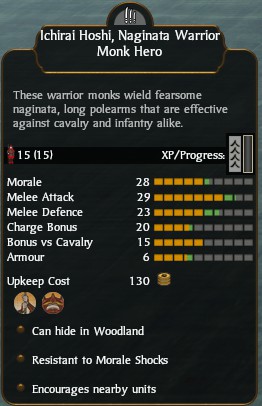
Cost: 1200
Naginata Warrior Monk Heroes are the ultimate hand to hand warriors, men who have perfected the art of battle with the naginata and now move in a beautiful and deadly dance with those who dare oppose them. Able to engage and destroy any unit, these men represent the pinnacle of Gempei warfare. Such is their commanding aura on the battlefield, that men near them will Hold Firm, making them harder to kill and never faltering. They are still men, however, slain by arrows or massed numbers. For each warrior that falls, scores of enemies will have been slain. The Naginata Warrior Monk Heroes require a Legendary Koryu Dojo and Famous Buddhist Temple.
Ingame encyclopaedia - Naginata Warrior Monk Hero posted:
A warrior with unshakable faith can be very dangerous, for the truly devout have little fear of death. For these monks, faith is not just a matter of conscience, but a weapon. It gives them very good morale in battle. They each carry a naginata, a long staff with a sword-length blade on the end. The long reach makes it effective against cavalry and infantry, but versatility is little protection against missiles. A naginata was weapon similar to the medieval European glaive: a long, wooden shaft with a curved killing blade. The blade varied in length and was, unlike a European glaive, as carefully made as any sword. These distinctive weapons were closely associated with warrior monks. Among the most famous naginata users was Gochin no Tajima, or "Tajima the Arrow Cutter", who fought in the battle of Uji in 1180. Tajima was part of a group of warrior monks pursued by the Taira; he made a stand at a bridge, whirling his naginata with such speed and expertise that arrows bounced harmlessly away.

Cost: 1100
The Tetsubo Warrior Monk Heroes are legendary warriors, armed with giant studded clubs. Only the strongest of men can wield these weapons, making them a terror in melee combat, able to beat their opponents with devastating strikes with an unstoppable fury and savagery. This incredible offensive power comes at a cost, however, with the Testubo Warrior Monk Heroes vulnerable to arrow fire and swarming of superior numbers. Warcry further heightens the terror of these warriors, letting them do their savage work more effectively. Used on the flanks or when supported by their own men, these heroes will crush all before them. Tetsubo Warrior Monk Heroes require a Buddhist Monastery and Koryu Dojo.
Ingame encyclopaedia - Tetsubo Warrior Monk Hero posted:
Armed with fearsome large, metal-studded clubs, these warrior monks are a terrifying sight as they charge into the attack. The size and weight of tetsubos makes them horribly effective in close combat: armour only serves to spread the impact of a blow, not keep it out. The monks disdain armour, and this makes them vulnerable to missile attacks. They can also be overwhelmed by large numbers of lesser attackers. The tetsubo is a weapon that requires immense strength to use properly, so it is hardly surprising that oni, the fearsome demons of Japanese legend, are often credited with using these clubs. The reputed strength of oni is still used in saying such as an "oni with an iron club" to mean something that is simply invincible, and "giving a kanabo to an oni" or giving the advantage to someone who already has quite enough advantages, thank you. Oni are still placated, or warded off, in modern Japan: during the springtime Setsubun festival families throw soybeans outside of their homes to bring good luck and ward off passing oni.
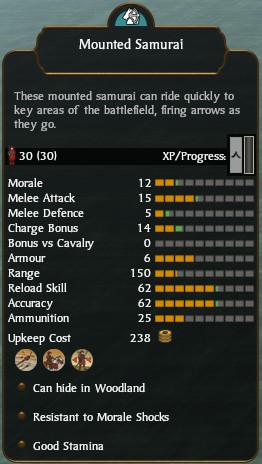
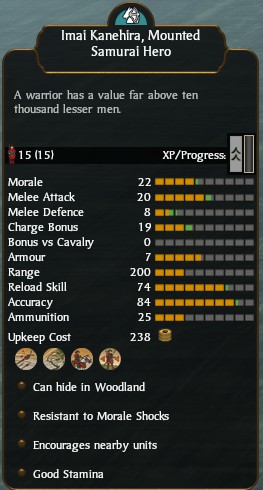
Cost: 800/1300
Able to strike with deadly speed a precision, the Mounted Samurai combine the incredible ranged firepower and melee skill of samurai with the mobility of cavalry. Able to launch the incredible Whistling Arrows, these men are unmatched on the battlefield and provide an incredible mobile terror for the aspiring general. They are vulnerable to massed arrow fire and should not be left in a sustained archery duel, nor should they engage naginata wielding troops in melee. Mounted Samurai require a Bushi Dojo and Pastures. The Mounted Samurai Hero are warriors of complete perfection. Able to launch arrows further than any other man, with accuracy and speed that comes only from a lifetime of mastery, all fear them. Such power inspires the men around them to fight harder and longer than ever before, bringing about a Second Wind. In addition, Mounted Samurai Heroes are deadly melee warriors, able to effortlessly slay all but the most elite troops. Mounted Samurai Heroes are few in number and vulnerable to sustained arrow fire and naginata troops. They require a Legendary Bushi Dojo and Pastures to recruit.
Ingame encyclopaedia - Mounted Samurai posted:
With both hands busy aiming and firing their bows, samurai cavalry must use their knees to control and steer their mounts. This requires intense training for both man and beast. These archers can move quickly to the enemy's flanks, or harass them from a distance. If caught in melee, the samurai have enough training to defend themselves, but they should probably avoid fighting naginata-armed infantry units. Their relatively few numbers makes them vulnerable to a massed attack by archers: weight of numbers will overpower even skilled warriors. Samurai were expected to be proficient in the use of a number of weapons but, during this period, archery was widely regarded as the best way to demonstrate a warrior's true skills. Battles were occasionally settled by mounted archery duels, performed by each army's most skilled archer. Opponents would ride towards one another and fire a single arrow. This "jousting with bows" could be repeated several times as fatal wounds were seldom inflicted during the early passes. The participants were trying their best to kill each other, but their armour was extremely good at keeping out arrows! Instantly fatal wounds were rather difficult to inflict.
Ingame encyclopaedia - Mounted Samurai Hero posted:
These mounted warriors are armed with bows and deadly naginatas, making them powerful in both close and ranged fights. Excellent shots, these men can fire while mounted and ride quickly to critical points of the battle line. Weak only in numbers, the heroes must be careful when near massed archers, and when in close combat against numerically superior forces. They are a deadly force under any general's hand. The samurai ideal of embracing death rather than dishonour plays a large role in the noble, and brutal, mystique of these warriors. The first instance of seppuku, or ritual suicide, is recorded as taking place at the start of the Gempei War. Minamoto no Yorimasa, a 74-year-old poet and warrior, gave up his position with the Taira to join the Minamoto rebellion. He led the Minamoto forces at the Battle of Uji and, following a crushing defeat, chose to take his own life rather than be captured. Legend has it that his retainers took his head, fastened it to a rock, and threw it into a river to keep the Taira from having it. The river had failed to stop the Taira advance.
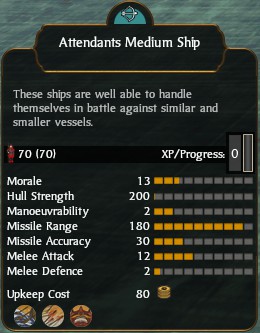
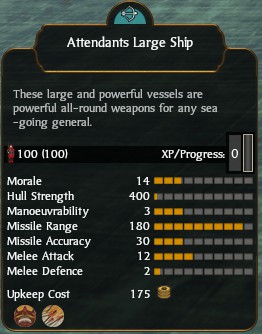
Cost: 350/550
A staple of the fleet, Attendants Medium Ships are not as fast as their Light cousins and not as well manned as their Heavy cousins, but their strength is in their flexibility. Able to use devastating Fire Arrows, capable of Fast Rowing and able to unleash the mighty Warcry, there is no naval role that this ship is unsuitable for. Manned only by Attendants, it will have difficulty engaging Samurai ships. The Attendant Heavy Ship is a terror of the seas, slow and powerful, able to overwhelm even a Samurai Medium Ship with it's large crew complement. Able to unleash a terrifying Warcry and Fire Arrows, the lack of mobility is this ships key weakness.
Ingame encyclopaedia - Attendants Medium Ship posted:
Attendant medium ships are solid, dependable vessels without any particular weaknesses. Their all-round usefulness, however, means that they are not outstandingly fast: they are a compromise, and like all compromises, excellence in any particular area is sacrificed in the interests of adequacy overall. Their crews are armed with bows and swords, giving them the ability to board enemies or stand off and pepper them with arrows. The crew have good morale, but they are not capable of taking on samurai in an equal or fair fight. A good commander needs to give them every advantage if they are to succeed against samurai. Historically most naval powers have had to build ships that are a compromise between speed, manoeuvrability and combat power. They also have to keep an accountant's eye on the cost of their warships. Usually the end result is a ship that can do most things quite well, but nothing brilliantly. The Japanese were no different in having to address these problems, with an additional one that their fighting men regarded satisfying honour as more important than good seamanship.
Ingame encyclopaedia - Attendants Heavy Ship posted:
Able to attack at range with arrow fire, and by boarding, attendant heavy ships are an extremely useful part of any balanced fleet. Like many Japanese vessels, they are intended to use boarding actions to defeat the enemy, with on-board soldiers swarming over the enemy decks. Given the soldiers' high morale, this is a valid stratagem, and one that regularly wins battles. So, these powerful vessels and their crews are almost capable of taking on anything else afloat: almost, but not quite. Against well-handled large ships with samurai aboard, they will generally get the worst of any fight. Apart from that, they should be a terror to anything else afloat. No general of the Gempei period wasted much time with considerations of wind and wave. He knew that the way to victory lay in putting his vessels alongside the enemy as quickly as possible and turning the affair into a floating land battle. The better commanders did recognise that there was a good deal of sense in trying to isolate and attack individual squadrons within enemy fleets, gaining local superiority before moving on to fresh victims. The poorer commanders just let their men have their heads and go into battle pell-mell, trusting to swordsmanship and honour to carry the day.

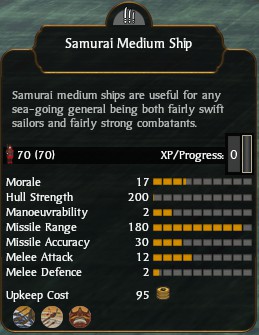

Cost: 200/450/650
The Samurai Light Ship is the smallest of the elite ships, able to easily take a Small or Medium Attendant ship in combat. Armed with Whistling arrows and the deadly accuracy of the samurai, few can stand against them. However, their small crew size makes them vulnerable to being surrounded or mobbed by sheer numbers. The Samurai Medium Ship is the slowest of the samurai ships, but with a large crew complement and access to the devastating Warcry, the only ship that can stand against it is the mighty Samurai Large Ship. The Samurai Large Ship lacks the burst speed available to the lighter ships, but the many rowers give it a respectable top speed. With an exceptionally large crew complement of the finest samurai, this ship is a terror on the seas, able to crush many lesser foes with ease. Armed with Whistling Arrows and packing the dual punch of Warcry and Rally, no other ship could hope to outlast them in combat.
Ingame encyclopaedia - Samurai Light Ship posted:
Samurai light ships are the "cavalry" of sea-battles: quick, nimble and capable of striking down unwary enemies. Their samurai crews are armed with bows and swords, meaning that they can attack their targets during the approach, and be surprisingly strong during a boarding action too. Better still, as samurai they have good, solid morale and are unlikely to waver in battle. However, they are vulnerable if fighting larger ships, simply because the respective numerical crew strengths that can be brought to bear. A light ship carries fewer men, and can therefore sustain fewer casualties. A wise commander uses these ships to attack and possibly capture stragglers in an enemy fleet. Their speed means that, against heavier, slower enemy ships, the light ships have the advantage in choosing where and when to fight. Given their relative high speed in action, they can decide whether or not to accept battle at close quarters, engage in an archery contest, or even harass enemies and then withdraw when pursued. Their "bite" when brought to battle is more than adequate thanks to the samurai aboard.
Ingame encyclopaedia - Samurai Medium Ship posted:
These medium ships are well-suited to most naval tasks, and have no real weaknesses. Their samurai crews are all excellent warriors, if not particularly good sailors, and are armed with swords and bows. A samurai medium ship can stand away from a target and pepper it with arrows, or close and board; the samurai warriors make it a formidable force in any boarding action. This dual use gives a commander many options when it comes to battle, although the primary use of these ships is in boarding actions. This ship type is ideally suited to the tactics of the Gempei period. Naval battles nearly always became large scale boarding actions as ships were lashed together and their crews fought savage hand-to-hand battles. Even more so than land battles, no quarter was asked or given, and the losers could expect nothing better than a watery grave. As far and as often as possible, a sea-general would try to engineer mass boarding battles so that his warriors' fighting spirit could be used to full effect.
Ingame encyclopaedia - Samurai Heavy Ship posted:
Samurai heavy ships carry large contingents of soldiers armed with bows and swords. This gives them excellent attacks both at range with arrows and in boarding actions. Against smaller ships, the samurai should have little trouble in sweeping all before them. The samurai also have high morale, thanks to their sense of personal honour: they are unlikely to back away from any fight. The only shortcoming is that their comparatively slow speed means that they can be outrun or outmanoeuvred. The samurai were not natural sea-warriors. Their strengths, traditions, habits and inclinations were all about combat on good, firm dry land. However, by playing to those strengths they were able to give good account of themselves in battle, as long as boarding actions were involved. In terms of seamanship, the samurai were not much help at sea. Manual labour was considered beneath consideration by the warrior classes, and sailing in medieval craft always required a lot of hard work.

Cost: 100
Exceptionally weak in combat, the Trade Ship allows the importing of foreign trade goods (Chinese Texts, Incense) if it is placed upon an appropriate sea trade node. Additional Trade Ships in the fleet increase the number of trade goods that are imported, although with diminishing returns.
Ingame encyclopaedia - Trade Ship posted:
Trade ships are not intended to get involved in any kind of battle. They exist to make a profit carrying cargoes, and crews should only be expected to fight only in defence of their own lives and their masters' goods. At need, trade ships could be used in battle to board enemies, but against any but the weakest of opposition the prospects of success would be very slim. Japan is a land of rugged, difficult terrain and roads were few and far between. During the medieval period, the easiest way of moving any kind of goods over any distance was by water. A few men with a ship could move cargoes that would have required hundreds of loads on land. The ever-present risk of pirate attack meant that no trade ship could ever be completely defenceless, but the best protection against pirates was always to see them coming and sail in the opposite direction as speedily as possible!

Cost: 400
Firebomb Ships use devastating exploding claypots loaded with gunpoweder to inflict fear and confusion upon enemy ships, as well as to set their foes alight. Short ranged, vulnerable to arrow fire and boarding, these ships must be used carefully, but are capable of the destruction of every other ship in the game. Available only at a Drydock and requiring support, properly used these ships are unbeatable. Their crew consists of the bravest and strongest men, able to row at great speeds or draw upon the fury of Banzai! to ensure the job gets done, no matter the cost.
Ingame encyclopaedia - Firebomb Ship posted:
Firebomb ships are unusual vessels because they are used to attack the fabric of other ships rather than kill their crews. They have a short range attack that causes much damage, but are vulnerable to boarding counter-attacks: fireship crews are not trained for close combat. Most of their expertise concerns their dangerous and inflammatory weapons, which are pots filled with assorted demonic sulphurous chemicals, and men who use such devices need much courage before they even face an enemy. This gives them excellent morale in battle, as any danger from enemies has to be measured against the danger of the firebombs themselves. Firebomb ship crews have the Banzai special ability. Although gunpowder weapons were not employed during the Gempei War, the technology was available in China and would have been known to the Japanese by repute if nothing else. Gunpowder, and assorted unpleasant ways of using it against enemies, had been invented by accident in China some 200 years earlier. Alchemists had been searching for an elixir of immortality, a quest common to the profession across the world. European alchemists would spend centuries looking for the "philosopher's stone" for its immortal benefits. Gunpowder and its successors, on the other hand, are almost certainly one of the greatest causers of mortality yet discovered.